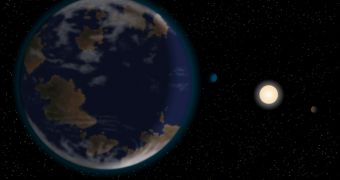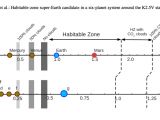Finding a new exoplanet isn't as exciting as it was a decade ago, it's fairly trivial at this point. However, finding a planet that could potentially harbor life is still a big event.
A group of astronomers using ESO's HARPS instrument have found [PDF] three more Earth-like planets around a nearby star that was already known to house three of them.
That's the same instrument that found Alpha Centauri Bb, the closest exoplanet to Earth yet.
Of these new three, one in particular is very exciting to astronomers. While it's seven times bigger than our planet, it's located very comfortably in the habitable zone of the star.
The dwarf star HD 40307 is situated at about 42 light years away, though it came much closer 413,000 years ago when it was just 6.4 light years away. It's slightly smaller and lighter than our Sun and shines in orange-tinted light.
The star is now believed to be the home of six super-Earths, rocky planets that are significantly larger than our own, labeled HD 40307 b, c, d, e, f, g.
HD 40307 g is the planet that's getting the most attention, while all the others are packed in tight orbits around their star, all closer than Mercury is to the Sun, the last one is at around 0.6 AU, where 1 AU is the distance between the Earth and the Sun.
But because the star is smaller, the planet gets about 62 percent of the radiation the Earth receives from the Sun.
It orbits its star in around 200 days. At that distance and with the amount of light hitting it, it should be able to harbor liquid water, a prerequisite for life as we know it.
It's also far out enough for it not to be tidally locked to its star, meaning it has a day/night cycle. This too favors life, a tidally locked planet can give rise to much more violent weather and climate.
Obviously, the discovery still has to be confirmed by other observations and, even if the planet is where and how it's supposed to be, there are many, many other factors that could influence whether it is favorable to life or not.
And, of course, even if the planet were favorable to life like the one we have on Earth, it doesn't necessarily mean that life has evolved there or that it still exists.

 14 DAY TRIAL //
14 DAY TRIAL // 

